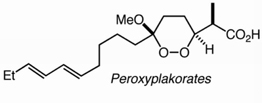Department of Chemistry
Document Type
Article
Date of this Version
2012
Citation
J Org Chem. 2012 February 3; 77(3): 1233–1243.
Abstract
The first singlet excited state of molecular oxygen (1O2) is an important oxidant in chemistry, biology, and medicine. 1O2 is most often generated through photosensitized excitation of ground state oxygen. 1O2 can also be generated chemically through the decomposition of hydrogen peroxide and other peroxides. However, most of these “dark oxygenations” require water-rich media associated with short 1O2 lifetimes, and there is a need for oxygenations able to be conducted in organic solvents. We now report that monoactivated derivatives of 1,1-dihydroperoxides undergo a previously unobserved fragmentation to generate high yields of singlet molecular oxygen (1O2). The fragmentations, which can be conducted in a variety of organic solvents, require a geminal relationship between a peroxyanion and a peroxide activated towards heterolytic cleavage. The reaction is general for a range of skeletal frameworks and activating groups and, via in situ activation, can be applied directly to 1,1-dihydroperoxides. Our investigation suggests the fragmentation involves rate-limiting formation of a peroxyanion that decomposes via a Grob-like process.



Comments
Copyright © 2012 American Chemical Society